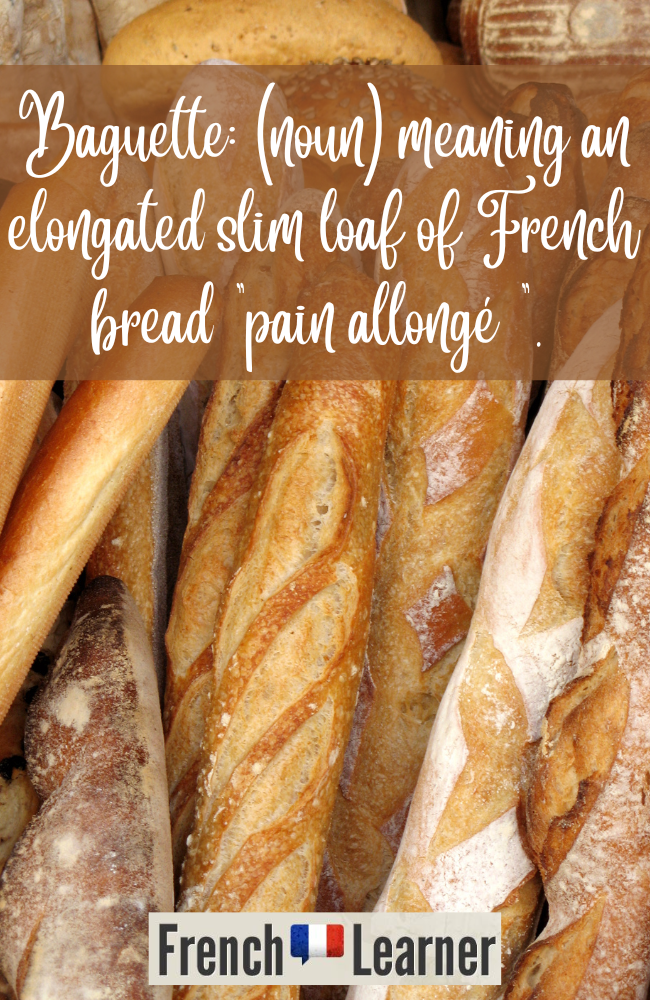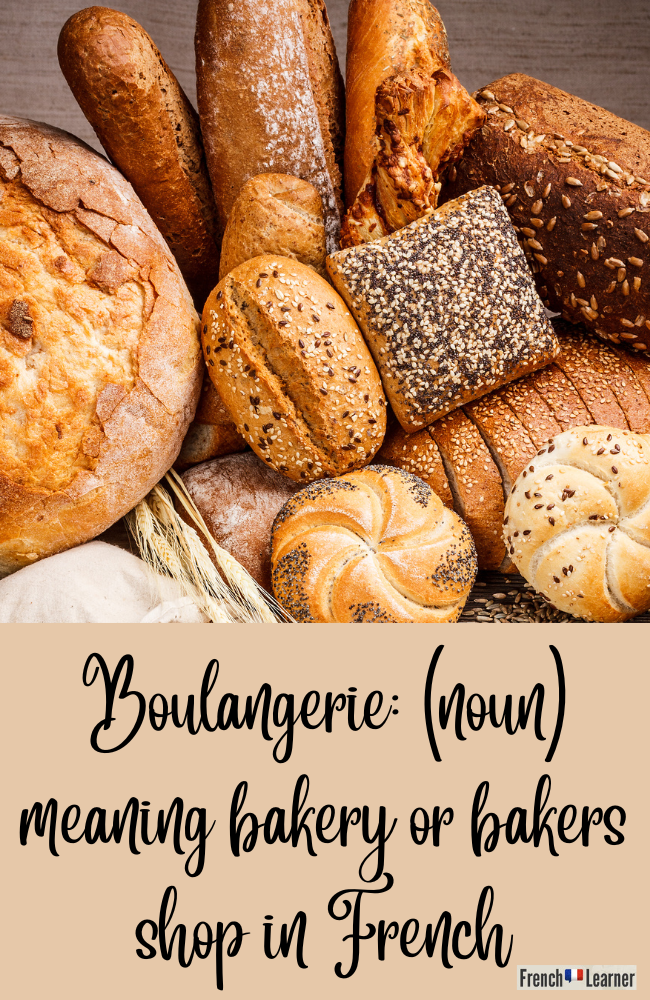Imagine you’re walk into a warm French bakery filled with the scent of freshly baked bread, but you don’t know what or how to order. This post covers everything you need to know about baguettes in France – including how to pronounce the different varieties.
baguette
/bah-get/

Baguettes In France
Baguettes (Meaning: French bread stick; Pronunciation: bagɛt) might just be the quintessential French food. Even the image of the stereotypical French person with their beret and striped shirt will often have the tip of a baguette popping out of their bag.
But always having a baguette is one stereotype that truly does ring true in France. My kitchen table in Paris now feels empty without one. My bi-weekly trip to the boulangerie has become a necessity.
But there is a lot you might not know about baguettes in France. Not only is there a wide range of different baguettes, but there are also certain rules and superstitions that go with buying and eating baguettes in France.
If you’re a bread lover and want to make sure you’re getting everything right on your next trip to France, you’ll find everything you need in this very delicious guide to baguettes.

Which Baguette to Order In France
If you were to walk into a French bakery right now you’d be greeted by both the comforting smell of freshly baked bread and a few different baguette varieties.
The most classic baguette is the baguette blanche. It is also known as the baguette parisienne or baguette classique. The French make these baguettes with simple white flour and it has a very airy with a thin, crisp crust.
Baguette Blanche
If you’re looking for something fluffy and light, you’ll love the baguette blanche. But just make sure you’re going to enjoy it pretty soon after you buy it. If not, these baguettes will turn hard as rock in a day or two.
baguette blanche
/bah-get blansh/
Baguette Tradition
Next up is the baguette tradition or artisanale. This baguette has a chewier bread consistency and a slightly thicker, crunchier crust.
These baguettes are also bread at their simplest and cannot have any additives. Their ingredients consist of simply flour, yeast, water, and salt.
baguette tradition
/bah-get trah-dee-sion/
Baguette de Campagne
Most boulangeries will also offer some sort of baguette de campagne or baguette rustique. This is really similar to the baguette tradition. But, it’s usually made with some sort of whole wheat flour and often contains more yeast.
Usually, this is the closest thing you can find to sourdough depending on how your bakery prepares this type of baguette. These types of baguettes are personally my favorite!
baguette de campagne
/bah-get duh cam-pah-nyuh/
Unique Baguettes
Also, you’ll usually have some sort of special baguette type. This might be a baguette aux graines, which the French make with whole wheat flour and a variety of seeds.
Or there is a baguette aux grains de pavot, which has poppy seeds in it. After that, certain boulangeries might get more creative. I’ve even had a chocolate baguette before!
baguette aux graines
/bah-get oh-grehn/
Different Baguette Sizes
Finally, there might be a few different size options. You’ll find a demi baguette, which is about half as small as a normal baguette. Some boulangeries also offer baguettes that are about half a gram larger than their regular baguettes.
demi baguette
/duh-mee bah-get/
So if you see a baguette that looks similar to the others, but has a different name, it might just be slightly bigger than the others.

How to Ask for A Baguette in France
Now that you’ve become an absolute baguette expert, you might want to know how to ask for your baguette of choice in a boulangerie.
First up, you should always say make sure you know how to say bonjour before you walk into a boulangerie. The French consider it rude to begin speaking with someone without saying hello first.
If you want to ask for a baguette you can say this:
- Est-ce que je peux avoir une baguette tradition s’il vous plaît ? Can I have a baguette tradition please?
Baguette Superstitions
There is one very common superstition when it comes to baguettes. It is to never place your baguette upside down on the table. The flat part should always be facing down unless you want to bring bad luck into your household.
This is because in the medieval ages, many crimes were punished by execution. During this time, the French popular looked down upon the executioner.
Despite this, the baker would usually reserve a baguette for the executioner each morning. In order to differentiate his baguette from the rest, he would flip it over.
Everyone in the town knew this. So, they would purposely avoid the flipped-over baguette. They did this so that nobody thought they were at all connected with the executioner. Now a flipped-over baguette has ties to death, bad luck, and even the devil.
Baguette Etiquette
If you’re ever invited over to dine at a French home, you will likely encounter a baguette during your meal. For some, the baguette will make its grand entrance after the main course so you can enjoy it with some cheese.
For others, the hosts will place a baguette on the table alongside the main course so that you can use it to support your fork while eating. You can also use it to wipe up any leftover sauce or crumbs at the end of your meal.
Some consider using a piece of baguette to wipe your plate clean to be rude, but most french families will do this. So you might just want to avoid this in a restaurant depending on who you’re with.
Also, some families rip a piece of bread right off from the baguette while others use a knife. If you’re not sure which is the best option, using a knife is a safer bet, but you can also wait and see what those around you are doing.
Finally, the French only enjoy their baguettes with butter during breakfast. So if you’re expecting some bread and butter to go along with your dinner, you will most likely not find that happening in a French home.
Other Baguette Definitions
If you’ve started studying a little bit of French you might have already heard French speakers use the word baguette to refer to other item. The French call this bread type baguettes because of its long, thin shape. So there are a few other long, thin items that the French also call baguettes.
So baguette can also mean:
- Stick
- Wand
- Rod
- T-bar
- Chopstick
- Baton
- Drumstick
- Leg (slang)
I’ve always found it funny that a magic wand is simply baguette magique in French. Voldemort’s wand doesn’t seem nearly as threatening or scary when it’s referred to as a baguette magique. And with that I wish you an enjoyable day filled with baguettes!

